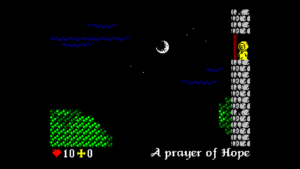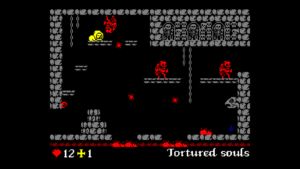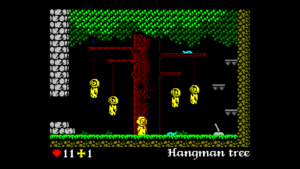L’Abbaye des Morts is one of the older, and definitely one of the shorter, games released by Locomalito and I admit to having some nostalgic fondness for it as it was the first game I ever played by this developer of Hydora and Maldita Castilla (as well as quite a few other games). Described on its website as “An obsolete video game for a dark passage of history,” l’Abbaye des Morts takes on the aesthetic stylings of a ZX Spectrum game as it tells the story of Jean Raymond, a 13th century Cathar who attempts to escape a group of crusaders only to find himself trapped in an abandoned church overrun by evil. Though the entire game can be finished in about ten minutes, this unusual platformer packs plenty of variety and creativity into its 23 single-screen rooms.

Despite its small size and a rather generous supply of extra lives scattered around the map, you’re not likely to complete this game on a first attempt, partly due to the time it can take to learn how to fully utilize Jean’s capabilities. Other than walking, Jean is only able to jump, duck, and crawl, but there is a bit more nuance to these abilities than it first appears. Many projectiles and horizontally-moving enemies can be avoided simply by ducking, often making it more beneficial to crawl than to walk. More importantly, Jean has a very fixed jump. Not only is his jump height fixed regardless of how long you hold down space, but his air time is also fixed so if Jean hits his head on a platform before reaching the peak of his jump he will remain in the air at that height for the full duration of his jump instead of immediately falling back to the ground. This fixed jump duration is the key as Jean is able to avoid hazards above him while making horizontal jumps by hitting his head on a platform before crossing the gap. Jean is also able to avoid patrolling enemies and projectiles on small platforms by jumping straight up on the edge; he will stay in the air long enough for enemies to patrol underneath him and turn back around even if he spends the majority of his time in the air with his head pressed up against the bottom of a platform. Even though the platforming is simplistic, it retains a distinctive feel because the room layouts and enemy designs usually are made with Jean’s specific style of jumping in mind.

Another reason why this game is likely going to take multiple attempts is its surprisingly nonlinear nature. Notes placed on the ground in early rooms make it clear that there are 12 crosses to collect, but it is up to the player to figure out why and what to do with them. Cryptic hints on how to obtain several of the seemingly unreachable crosses are scattered around the map and there are a few instances where a lever in one room will open a door in another. These opened doors and puzzle-oriented crosses are easy enough to reach once you know how, but the hints are just vague enough to leave room for some stumbling around and trial and error before you figure out the solution. Checkpoints are placed generously, about a third of the rooms contain a checkpoint statue, and several of the earlier rooms have three-way splits. On top of this, four of the crosses start as evil, upside-down versions and can only be collected by interacting with an object in one of the rooms which flip-flops all of the crosses. As a result, you have a lot of control over the path you take, which direction you enter and leave each room from, and just which parts of the abbey you backtrack through.

Even if you don’t finish the game during a run, you inevitably will learn more about the abbey’s structure and can use that knowledge to create an ideal path for collecting the eight normal crosses before converting and sweeping up the reversed crosses. Crosses remain in your inventory even if you die after collecting them and checkpoints are easy to avoid, so this game is great for speedrunners who don’t mind deliberately losing a life to save time backtracking by warping back to old checkpoints. L’Abbaye des Morts strikes an ideal balance of having a layout and puzzles which are complicated enough to provide a decent amount of playtime before you first reach its ending while still being short and open enough to become highly replayable.

For a game with such a deliberately limited color palette and an even more limited use of sound, the aesthetics here are wonderful. Sound effects have a sharp crispness to them and, though they are all short, there are slightly over half a dozen songs in the game so you never are stuck with the same music for long. There is a surprising amount of detail placed into the walls and background objects with plenty of skulls, cracked bricks, and signs of evil and dilapidation to establish the setting and enhance the atmosphere. There are only 16 colors used throughout the entire game, but bright colors are always chosen for enemies and projectiles to make them easily distinguishable from their surroundings with the exception of large drops of water which are somehow deadly and can be mistaken for background objects. With the sole exception of the first ‘boss’ of the game, every enemy seems to be limited to two frames of animation, yet these frames are synched up perfectly with the movement and attack speeds of enemies to create an oddly fluid sense of motion for every adversary from small spiders to marching soldiers and skeletal archers. There are also many small graphical touches along the way to add an even heavier layer of polish, such as Jean bursting into flames and his face transforming into a skull upon death, a unique name for each room (some of which can serve as hints), and a few cases of environmental storytelling, such as a room with four corpses in Cathar robes hanging from a tree, presumably representing the four holders of the reversed crosses who abandoned their faith. Limitations are turned into strengths across the board to create a game which looks, sounds, and plays exceptionally well.

I would not consider l’Abbaye des Morts to be the best game which Locomalito has made, but its unique setting, entertaining and replayable gameplay, and an all-around sense of polish certainly make it deserving of the praise and the cult following which it has received over the years.